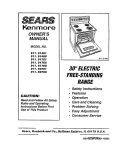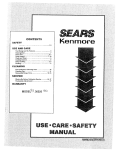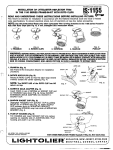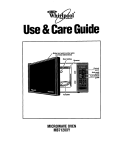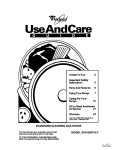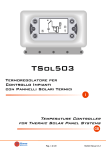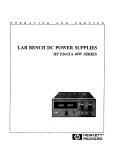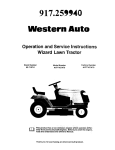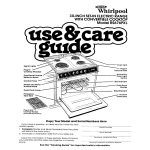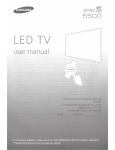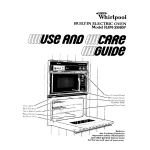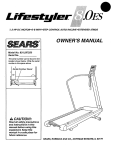Download Sears KENMORE 45521 User's Manual
Transcript
Kenmore
CONTENTS
SAFETY
USE
ANO CARE
Your Range and Its Features ....................................
5
Cooktop Cooking ...................................................
6, 7
Oven Controls .................................................
8, 9, 10
Oven Cooking ...........................................................
10
Broitin9 ................................................................
11
Self-Clean Cycle _.....L, ......................................
12, 13
Cleaning Tips .........................................................
14
Removable Range Parts .....................................
15-17
SERVICE
Before Calling For Service ................................
18, 19
Adlusting Oven Temperature
.................................
20
WARRANTY
MODELS 45520, 45521
USE • CARE • SAFETY
MANUAL
__%
_%_
IMPORTANT
INSTRUCTIONS
FOR YOUR SAFETY
SAVE
Read all Instructions
appliances,
basic
safety
before
THESE
INSTRUCTIONS
using this appliance.
precautions
should
be fallowed,
When using electrical
including
the
following:
Teach children not to play
with control knobs or any
other part of the range.
Never
alone
where
leave
children
or unattended
a range
is in use.
Caution:
Never store things children might want above a
range.
Never
let anyone climb,
sit or stand on the range.
They might be injured on a
hot surface.
Never leave an oven door
open when you are not
watching.
1
NESAF52
%?
......
Always keep the range area clear
and free from things that will burn.
iii!i! !i!i!ii
Never use your range for warming
or heating a room. You could be
burned or seriously injured. Such
misuse could also cause damage to
the range,
CAUTION:
Never store things in an oven
or near
cooktop
elements/
burners. These things may catch
fire and plastic items could melt.
Never wear loose clothing when
using your range. Such clothing
could catch fire.
Never use a towel or ot her bulky cloth
as a potholder. Such cloths could
catch fire on a hot element/burner.
Never let pot handles stick out
over the front of the range. Turn
handles in so that they cannot be
bumped into. Keep the handles
away from other hot surface elements/burners.
Never
leave cooktop elements/
burners unwatched at high heat
settings, Bollovers cause smoking and greasy spillovers
could
catch fire.
2
NESAFO9-2
IMPORTANT
SAFETY
INSTRUCTIONS
Keep this book for later use.
Be sure your range is Installed and grounded properly
by a qualified technician.
Always use care when touching cooktop elements,
areas near thecooktop elements, oven heating elements
or Inside the oven. Heating elements could be hot
enough to burn you even If they are dark in color. The
oven vent duct and oven door may also become hot
during oven use.
After broiling, always take the broiler pan out of the
oven and clean It. Leftover grease In the broiler pen can
catch on fire next time you use the pan.
Always use dry potholders when removing pans from
the oven. Moist or damp potholders can cause steam
burns.
Always use care when opening oven door. Let hot air
and steam out before moving food.
Always keep the range and oven clean. Food and
grease a re easy to Ig nlte. Clean the rang e, oven and vent
hood regularly.
Always keep combustible wall coverings, curtains or
drapes a safe distance away from your range.
Always keep dish towels, dish cloths, potholders and
other linens a safe distance away from your range.
Always keep ca nned food and wooden or plastic utensils
a safe distance away from your range.
Always follow cleaning instructions in this book.
Choose pots and pans with flat bottoms large enough
to cover the entire cooktop element. This will cut down
the risk of setting potholders or clothing on fire with an
uncovered element and waste less energy.
Only certain kinds of glas s or ceramic pans can be used
for cooktop cooking. Be sure that the pan you use will
not break when heated on the cooktop elements.
Teach children not to play with oven controls or any
other part of the range.
Always remove the broiler pan and other utensils from
the oven before a self-clean cycle.
Be sure the range is securely Installed In a cabinet that
is firmly attached to the house structure. Weight on the
oven door could potentially cause the oven to tip and
result in Injury. Never allow anyone to clind), sit,
stand or hang on the oven door.
Always keep the appliance area clear and free from
things that will burn, gasoline and other flammable
vapors and liquids.
Never heat unopened food contalnere. Preseura buildup
may make container burst and cause Injury.
Never leave jars or cans of fat or drippings on or near
the oven. Never let grease build up on your oven. You
can keep grease fires from starting If you clean up
grease and spies after each oven use.
Neverusealumlnum folltollne oven bottoms. Improper
use of foil could start a fire.
Never block free airflow through the oven vent.
Never try to move a pan of hot fat, especially a deep fat
fryer. Walt until the fat has cooled.
Never leave children alone or unattended where a
range Is In use.
Never use your range for warming or heating a room.
Such use can be dangerous and can damage oven parts.
Never wear loose fitting or henglng clothes while using
your oven. Such clothes could catch fire and cause
serious Injury.
Never use a towel or other bulky cloth as a pothoider.
Such cloths could catch fire on a hot element.
Never put removable heating elements In water. Don't
put them In a dlahwasher. Do not put them In the selfclean cycle of self-cleaning ovens.
Never use the cooktop without reflector pans or drip
bowls In piece. If these pans or bowls are not there
during cooking, wiring or other range parts may be
damaged.
Never clean cooktop surface when It Is hot. Some
cleaners produce noxious fumes and wet cloths could
cause steam burns if used on a hot surface.
Never try to clean utensils, cookware or removable
parts of your range In the oven during a self-clean cycle.
Do not use any type of commercial oven cleaner or oven
liner protective coating In or around your oven.
Never store things In an oven or on your range.
Do Not clean door gasket without following Instructlons
In this manual.
Never rob, move, or damage the door gasket on selfcleaning oven. The gasket is essential for a good seal.
If the self-cleaning
made malfunctions,
turn off
and disconnect the power supply. Have serviced by a
qualified technician.
Do Not Use Oven Cleaners--No
commercial oven
cleaner or oven liner protective coaUng of any kind
should be used in or around any part of the self-clean
oven.
Place oven racks In desired position while oven Is cool.
Clean
Only parts
listed
in the Manual.
Never try to repair or replace any part of the range
unless Instructions are given In this book. All other
work should be done by a sklllad technician.
A fan noise may be heard sometime during the clean
cycle. This Is normal.
NESAF49-1
IMPORTANT
Read
NOW!
and
SAFETY
understand
INSTRUCTIONS
this
(continued)
OVEN
information
FIRE
Do not try to move the pan.
Should you ever need
time for reading.
it, you will not have
Be sure everyone
in your home
what to do in case of a fire.
1.
Close oven door and turn controls off.
2.
If fire conUnues, throw baking soda on the fire, or
use a Hslon or dry chemical extinguisher.
knows
COOKTOP
GREASE
Never pick up a flaming
Never use water on a grease
only spread the flames.
IMPORTANT
SAFETY
fire - it will
FIRE
pan..,
instead:
1.
Turn off the element.
2.
Smother the fire with a tlghUy fitting pan lid,
baking soda or a Halon or dry chemical
exUnguIsher
NOTICE
The flherglass Insulation In self-clean ovens gives off a
very small amount of carbon monoxide during the
cleaning cycle. Exposure can be minimized byventlng
wlth an open window or using a ventilation fan or hood.
The Catifornla Safe Drinking Water and Toxic Enforcement Act requires the Governor of California to publish
a list of substances known to the state to cause birth
defects or other reproductive harm, and requires buslnesses to warn customers of potential exposure to
such substances.
4
NESAF50-1
YOUR
RANGE
IMPORTANT:
The model and serial number of your oven can be found on a tag located
below the lilt-up cook-top, at the rear.
Lift-Up Cooktop
(See page 17 )
Oven Vent (below
element - are8 may
hot during oven
use; DONOT BLOCK)
(See page 6)
Removable Chrome Bowls
(See pages 14 & 16)
Removable
Cooktop Elements
(See page 16)
Cooktop Indicator Light
(glows when any cooMop
element is on) (See page 6)
Oven Light Switch
(Push to turn oven
light on and off)
Cooktop Control
(See pages 6, 14 & 16)
Self-Cleaning Oven
(See pages 12, 13 & 14)
Oven Control
(See pages 8, 9, 13 & 20)
RemovableOven Racks
(See page 15)
Oven Door Latch
(Locks during self-clean
cycle; See pages 13 & 19)
Door Gasket
(See pages 12 & 14)
Removable Oven Door
(See page 15)
Bake Element
Broiler Pan & Grid
(See pages 11 and 14)
5
NEDIF02
To
Start Things
Cooking
COOKTOPCOOKING
The sign near each cooktop control knob shows
which element Is turned on by that knob.
O0
eO
Left
Front
To operate
eO
O0
Oe
O0
Left
Rear
cooktop
Right
Rear
For best cooking results and energy efficient operation,
you should use pans that:
O0
Oe
A. Have flat bottoms and straight sides.
B. Have light handles that do not tilt pans.
C. Are about the same size as the element.
Right
Front
controls:
1. Push cooktop control knob in and tumo
2. Set on or between marks for desired heat.
An Indicator light will glow when any cooktop elemenl
IS on.
When the oven Is on, heated air moves through a vent
under the right rear cooktop element. This hot air may
make pot handles hot or melt pissUc Items left too near
the vent. The vent is necessary for proper oven performance. Do not block It.
COOKTOP
CONTROL
f_
6
cooktop elements
with aluminum
toil.
Foil can block normal beat
flow and damage the range. This is
especially
true if foil Mocks
the
Never
below
oven ventline
tube the
underbowls
the right
rear
cooktop element.
NFMTC38-1
QUESTIONS
& ANSWERS
Q. May I can foods and preserves
units?
Q. Why am I not getting the heat I need from my
units even though I have the knobs on the
right setting?
on my surface
A. Yes, but only use cookware designed for canning
purposes. Check the manufacturer's Instructions
and reclpas for preserving foods. Be sure canner Is
fiat-bottomed and fits over the center of your surface
unit. Since cenntng generates large amounts of
steam, be careful to avoid burns from steam or heat.
Canning should only be done on surface units.
A. After turning surface unit oft and making sure It Is
cool, check to make sure that your plug-In units are
securely fastened into the surface connection.
Q. Why does my cookware
on the surface unit?
•
A. Because the surface unit or the cookware Is not flat.
Make sure that the "feet" on your surface units are
sitting tightly In the range top Indentation and the
outer edge of the drip pan is flat on the range surface.
Q. Can I cover my drip pans with foil?
A. No. CleanasrecommendedlnCleanlngTIps.
Donot
use aluminum foil to line drip pans or anywhere In the
oven except as described In this book. Misuse could
result In a shock, fire hazard, or damage to the range.
Q. Can I use special cooking equipment,
oriental wok, on any surface units?
Q. Why is the porcelain
coming off?
like an
CANNING
finish on my cookware
A. If you sat the temperatura of your surface unit higher
then required for the cookware material and leave It,
the finish may smoke, crack, pop or burn, depending
on the pot or pan. Also, a too high heat for ling
periods, and small amounts of dry food, may damag •
the finish.
A. We recommend flat bottomedwoks. Cookwarewithout flat surfaces is not recommended. The life of
your surface unit can he shortened and the range top
can be damaged from the high heat needed for this
type of cooking.
HOME
tilt when I place them
TIPS
3. Flat-bottomedcennersglvebestcannlngresults.
Be
sure bottom of canner Is flat or slight Indentation fits
snugly over surface unit. Canners with flanged or
rippled bottoms (often found In enamelware) are not
recommended.
In surface cooking of foods other than canning, the use
of large-diameter pots (extending more than 1" beyond
edge of drip pan) is not recommended. However, when
canning with water-bath or pressure canner, large-allameter pots may be used. This Is because boiling water
temperatures (even under pressure) are not harmful to
cooktop surfaces surrounding heating unit.
RIGHT
WRONG
HOWEVER,
DO NOT USE LARGE DIAMETER
CANNERS OR OTHER LARGE DIAMETER
POTS
FOR FRYING OR BOILING FOODS OTHERTHAN
WATER.
4. When cennlng, use recipes from reputsble sources.
Reliable recipes are available from the manufacturer
of your canner; manufacturers of glass jars for canning, such as Ball and Kerr; and the United States
Department of Agriculture Extension Service.
Most syrup or sauce mixtures -- and all types of frying
-- cook at temperatures much hlgherthan boiling water.
Such temperatures could eventually harm cooktop surfaces surrounding heating unIts.
OBSERVE
FOLLOWING
POINTS
5. Remember, In following the recipes, that canning Is
s process that generates large amounts of steam. Be
careful while cennlng to prevent burns from steam or
heat.
IN
CANNING
1. Bring water to boll on HIGH heat, then after boiling
has begun, adjust heat to lowest setting to maintain
boil (saves energy and best uses surface unit).
2. Besurecannerfitsovercenterofsurfaceunit.
If your
range does not allow canner to be centered on
surface unit, use smaller-diameter pots for good
canning results.
NOTE: it your range Is being operated on low power
(voltage), canning may take longer than expected,
even though dlrsctlons have been carefully followed. The process may be Improved by:
7
(1)
uslng a pressure canner, and
(2)
beginning wlth bet tap water when heating
larger quantItles of water.
NFMTC06-3
RANGE
CONTROL
PROGRAM
STATUS
DISPLAY
CANCELS BAKE,
BROIL OR
CLEAN OPERATION
CLOCK /
TIMER
DISPLAY
In
PRESS TO TURN
TIMER ON AND OFF
TEMPERATURE
DISPLAY
FUNCTION
DISPLAY
r
UP ARROW PAD
(INCREASES TIME
OR TEMPERATURE)
DOWN ARROW PAD
(DECREASES TIME
OR TEMPERATURE)
SET AUTOMATIC
OVEN OPERATIONS
Your range control is touch controlled. To set BAKE, BROIL, TIMER or CLEAN, touch the desired function pad and
select the temperature or time by touching the arrow pad. Hold your finger on the arrow pad to change display
numbers quickly. Touch and release the arrow pad to change display numbers slowly.
TO SET
THE
TO CANCEL
CLOCK:
1. Press the CLOCK pad. The word "TIME"
in the display.
will flash
THE
TIMER:
Press and hold the TIMER ON/OFF pad until the time
of day returns to the display (about 4 seconds).
2. Press the UP or DOWN arrow pad to select the
correct time of day. The clock will start automatically.
TO SET
BAKE:
1. Pressthe BAKE pad. "BAKE"will
flash inthe display.
2. Press the UP or DOWN arrow pad to select the
desired temperature. The last bake temperature you
used will appear in the temperature display. Increase
the temperature with the UP arrow pad. Decrease the
temperature with the DOWN arrow pad.
INCREASEORq
DECREASETIME
TO SET THE
NOTE:
If you do not set a temperature after you press BAKE, t he
display will go blank. Repeat steps I and 2.
3. When baking is complete, press the CLEAR/OFF pad.
TIMER:
The TIMER does not control oven operations.
The maximum time setting is 9 hours and
55 minutes.
1. Press the TIMER
in the display.
ON/OFF pad. "TIMER"
(_TO
will flash
2. Press the UP or DOWN arrow pad to select the
amount of time. The TIMER will automatically begin
counting down after a few seconds.
INCREASE OR DECREASE
TEMPERATURE
3. When t he time Is up, the end-of-cycle tone will beep.
Press the CLOCK pad to return the time of day to the
display.
TO RESET
THE
CANCEL BAKE
TIMER:
If you have set the timer and wish to change the time:
1. Press the TIMER
ON/OFF pad.
2. Press the UP or DOWN arrow pad to select the time.
8
NCERC14
TO SET BROIL:
DELAYED
ON AND OFF:
1. Pmss the BROIL pad. "BROILW will flseh and (- --)
will appear In thedlsplay.
You can set the oven to turn on and off autometlcelly.
The control will calculate the time to start cooking.
2. Select LO BROIL by pressing the UP arrow pad
once. Select HI BROIL by pressing the UP arrow
pad twice. To change from HI BROIL to LO BROIL,
press the DOWN arrow pad.
1. Press the COOK TIME pad.
3. After cooking Is complete, press the CLEAR/OFF
pad.
3. Press the STOP TIME pad. The OVEN CONTROL
will calculate the earliest stop time you can set. This
time will appear In the display.
2. Press the UP or DOWN arrow pad to set how long
you want to bake. Use the time given In your recipe.
TO CANCEL BROIL
4. Press the UP or DOWN arrow pad if you want to
change the calculated STOP TIME.
5. Press the BAKE pad.
6. Press the UP or DOWN arrow pad to select the
temperature. Use the temperature In your recipe.
7. Press the CLOCK
pad to return to the time of day.
PRESS ONCE T¢
PRESS "_VICE TO SET HI BROIL
TO RESET
BROIL:
If you do not select LO or HI BROIL the funCtion display
will go blank.
1. Press the BROIL pad.
INCREASE OR DECREASE TIME (
2. Press the UP or DOWN arrow pad.
TIMED
iNCREASE OR DECREASE(
TO SET STOP TIME
BAKING:
AUTOMATIC
OVEN
OFF:
iNCREASE OR DECREASEi
TO SET TEMPERATURE
NOTE:
You can begin baking now and set the oven to turn OFF
automatically.
If the control beeps, you have not completed your timed
oven sstUng. Press the CLEAR/OFF pad and start again
with Step 1.
1. Press the COOK TIME pad.
2. Press the Up or DOWN arrow pad to sst hew long you
want to bake_
The low temperature
zone of tMs
range (between 150°F and 2QO°F) is
available to keep hot cooked foods
warm.
Food kept longer than two
hours at these low temperatures
may spoil.
3. Press the BAKE pad.
4. Press the UP or DOWN arrow pad to select the
temperature you prefer. Use the temperature In your
r_lpa.
Never
let
food,
such
as
dairy
products, fish, meat, poultry, etc.,
sit for more than 1 hour before
cooking starts when you set your
oven for • delay start.
Room
temperature
promotes the growth
of harmful bacteria.
Be sure the
oven light is off because heat from
the bulb will speed bacteria growth.
INCREASE OR DECREASE TIME q
NOTE:
INCREASE OR DECREASE I
TEMPERATURE
You should consider that food left in the oven will
continue to cook after the control turns OFF,
unless you remove the food immediately.
9
NCCTL40
DISPLAY:
Once you have programmed your control for any
operation, you can display the setting by pressing the
appropriate pad. For example, if you are using the
TIMER and want to see the time of day, press CLOCK.
The display will show the time of day.
NOTE:
when heklng several hems stagger pans so that no
pan Is dlrecUy above another.
Let the oven preheat thoroughly before cooking
baked products. Listen for preheat notification tone
orwatch forths Indicator Ilghtto go off. If your range
does not have either of these features, preheat for 10
minutes end put the food In the oven.
You cannot set BAKE, BROIL or COOK TIME
while the oven door Is In the locked position. If
you try, the word "door" will appear In the
display. The oven door lock Is to be used for
Self-Cleaning only.
Opening the door too often to check food during
baking will allow heat loss end may cause poor
baking results.
TONES:
The end-of-cycle tone will sound at the end of timer use
and automatic oven functions. The end-of-cycle tone is
3 short beeps followed by I beep every 6 seconds that
repeat until you press any operation. If you would like
to eliminate the repeating beeps, push and hold CLEAR/
OFF for ten seconds. To return the 1 beep every 6
seconds, push and hold CLEAR/OFF for 10 seconds.
2 cake layers
To cancel the end-of-cycle tone, press any key except
the UP or DOWN arrow key.
F-CODE:
4 cake layers
If the time display beeps continuously and flashes an
"F" followed by a number, you have a function error
code. Note the number after the "F". Press CLEAR/
OFF. Allow oven to cool for 1 hour. If problem repeats,
dleconnoct all power to the range and call for service.
Advise your service technician of the number following
the "F" In the display.
Cakes, cookies, muffins, and quick breads should
be baked in shiny pens -- to reflect the heat -because they should have a light golden crust.
Yeast breads end pie crusts should be baked In
glass or dull (non-shiny) pans -- to absorb the heat
-- because they should have s brown, crisp crust.
Be sure the .undarslde of the pan Is shiny, too.
Darkened undersides will absorb the heat and may
cause over-browning on the bottom of your food.
OVEN COOKING
Oven temperatures should be reduced 25 degrees
below recommended temperatures If exterior of pan
Is predarkened, darkened by age or oven proof
glass.
When cooking a fond for the first time In your new
oven, use time given on recipes as a guide.
Your new oven has been set correctly at the factory
and Is more apt to be accurate than the oven It
replaced.
There may be some odor when t he oven Is first used.
This Is caused by the hesUng of new parts and
Insulation.
After you have used your oven for awhile, If you feel
your oven should be hotter or cooler, you can adjust
It yourself. See TEMPERATURE
ADJUSTMENTS
In this manual.
•
Do not cover an entire oven rack with foil. The foil
can block normal heat flow and cause poor baking
results. Do not place any foil dlrecUyabove the bake
element. Foil used on the oven bottom under the
element may damage the oven surface; therefore, It
should not be used.
Always follow recipe carefully.
Measure Ingredients properly.
Use proper pan placement.
Cookies should be baked on flat cookie sheets
without sides to allow the air to clreulate properly.
Place pans on the oven racks with 1" to 1 1/2" of air
space on all sides of each pan. Avoid overcrowding
the oven.
When recipes requlra preheating, have food nearby
before you open the oven door. If the oven door is
allowed to remain open for more then s brief t!me,
the preheat temperature will be lost.
Pans too close to each other, to oven walls or to the
oven bottom block the free movement of air. Improper air movement causes uneven browning and
cooking.
lO
NEOVC20
BROILING
POSITIONING
BROILER
PAN
Broiling Is cooking by direct heat from the broil element.
Tender cuts of meat or marinated meat should be selected for broiling. For best results steaks and chops
should be at least 3/4" thick.
After placing food on the broiler pan, put the pan on an
oven rack in the proper position.
The recommended
rack poslUon and cooking Urns can be found in the chart
below.
Most foods can be brolled at the HI Broll Sattlng. Select
the LO Broil setting to avoid excesstve browning or
drying of foods that should be cooked to the well-done
stage (such as thick pork chops or poultry).
BROILING
Please
The closer the food is to the broil element, the faster the
meat browne on the outside, yet stays red to pink in the
center. Mevlng the meat farther away from the element
lets the meat cook to the canter while browning outside.
Side one should be cooked 1 - 2 minutes longer than
side two.
TIPS
Rack
Position
4 - Highest
1 : Lowest
;Total Time
(minutes)
Rare
4
9-11
Medium
3
13-15
Well Done
3
21-23
Medium-1" Thick
3
16-18
Medium-l/2" Thick
4
7-9
Lamb Chops - 1" Thick
3
18-21
Pork Chops - 1" Thk:k
3
27-29
Pork Chops - 1/2" Thick
3
16-18
Ham Slice - 1/2" Thick
3
11-12
Fish (Fillets)
3
11-13
Chicken (Pieces)
2
45-55
Frankfurters
3
9.11
Bacon
3
9.11
note:
Food
Your oven door should be open to the broil
stop position while broiling.
If the door is
olosed, the food will roast and not broil.
Steak - 1" Thick
Use only the broiler pan and grid that came with your
range for broiling. They are designed for proper
drainage of fat and liquids and help prevent spatter,
smoke or fire.
Do not preheat when broiling. For even broiling
on both sides, start the food on a cold pan.
Ground Beef Patties
Trim the outer layer of fat from steaks and chops. Silt
the fatty edges to keep the meat from curling.
For maximum juiciness, salt the first side just before
turning the meet. Salt the second side just before
serving.
Brush chicken and fish with butter several times as
they broil. When broiling fish, grease the grid to
prevent sticking and broil with skin side down. It Is
not necessary to turn fish.
Never leave a soiled broiler pan in the range.
Grease in the pan may smoke or burn the next time
the oven is used.
Be sure you know the correct procedure for putting
out a grease fire. Seethe section on safety.
Do not cover the entire broiler
grid with foil (mold toil tightly
to grid and cut slits in foil to
align with slits in the grid).
Poor drainage of hot fat may
cause a broiler fire.
This chart is a general guide. The size, weight, thickness, and starting temperature of the food, as well as
your own personal preference, will affect the cooking
time. Times in the chert are based on the food being at
refrigerator temperature.
if a fire starts, close the oven
door and turn controls off. If
fire continues,
throw
baking
soda on the fire.
Do not put
water on the fire.
11
NEBRL22
THE
SELF-CLEAN
BEFORE
A CLEAN
CYCLE
CYCLE
1. Remove the broil pan and grid, oven racks, all utanslis
and any foil that may be in the oven. Do not try to
clean utensils or any other objects In the oven during
a self-clean cycle. If oven recks are left in the
range during a clean ¢yclej they will darkenj
lose their luster and become hard to slide. If
you choose to leave the racks In the oven, you can
polish the edges of the racks with steel wool and
apply a small amount of vegetable oil to the rack
edges after the self-clean cycle. This will make the
racks easier to slide.
3. Wipe up heavy splllovers on the oven bottom. Too
much soil may cause smoking during the clean cycle.
4. Do not rubthe door gssket. The fiberglass material of
the gasket has an extremely low resistance to abrasion.
An Intact and well fitting oven door gasket Iseasentlal
for energy efflcisnt oven operetlon and good baking
results. If you noUce the seal becoming worn, frayed
or damaged In any way or If It has become displaced
on the door, you should replace the gasket. The
gasket Is designed wnh a 5-6" gap at the bottom for
proper air clrcuisgon.
2. Soil on the oven front frame, under the front edge of
the cooktop, the door liner outside the door gasket
and the front edge of the oven cavity (about 1" Into the
oven) will not be cleaned during a clean cycle (see
IIIuetretlon below). Clean these areas by hand before
starting a clean cycle.
AFTER
A CLEAN
CYCLE
After a clean cycle, you may notice some white ash In the
oven. Just wipe It up with a damp cloth.
If white spots remain, remove them with a soap-filled
steel wool pad. Be sure to rinse thoroughly. These
deposits are usually a salt residue that cannot be removed by the clean cycle.
Use hot water with a soap-filled steel wool pad, then
rinse well.
FRONI" FRAME
If the oven Is not clean after one clean cycle, the cycle
may be repeated.
NOTE:
Your oven light should be OFF during a selfclean cycle to prolong the Ilte of the bulb.
This range has a fan that will turn "ON" and
"OFF" by Itself to keep the electronics cool.
Sometimes It will run after the range has been
turned off.
DOOR LINER
12
NESCL10-2
TO SET SELF-CLEAN
CYCLE:
TO INTERRUPT
1. Close oven door. Press the CLEAN pad. The time
display will show (---). See Fig. 1. You may need to
press slightly on the door.
A CLEAN
CYCLE:
1. Push CLEAR/OFF.
Follow InstrucUons under "WHEN
CYCLE IS FINISHED."
TO SET
DELAYED
A CLEAN
SELF-CLEAN
CYCLE:
1. Close oven door. Press the CLEAN pad. The time
display will show (--). See Fig. 1. You may need to
press slightly on the door.
Fig. 1
2. Press the UP or DOWN arrow pad to set the desired
length of clean time. Clean time is normally 3
hours. You can change It between 2 and 4 hours,
depending on how dlrtythe oven Is..See Fig. 2. The
door locks automatically after the controls are set.
The display will show "LOCK" when door locks.
2. Press the UP or DOWN arrow pad to set the desired
length of clean time. Clean time is normally 3
hours. You can change it between 2 and 4 hours,
depending on how dirty the oven Is. See Fig. 2. The
door locks automatically after the controls are set.
The display will show "LOCK" when door locks.
3. Press the STOP TIME,
4. Set the Ume of day when you want the clean cycle to
end. See Fig. 4,
The control will calculate when to start clean cycle time.
Fig. 2
You can push the STOP TiME to find out when the
cycle will end. Push the CLEAN pad to return to
countdown.
WHEN
A CLEAN
CYCLE
Fig. 4
Note'. When selecting a stop time for a delayed clean
cycle, you must allow Ume for the 2-4 hour clean
time.
IS
FINISHED:
Your oven light should be OFF during a self-clean cycle
to prolong the life of the bulb.
t. Walt until the LOCK display goes out. The oven
temperature must drop to s safe level before the door
can be opened. See Fig. 3.
CLEANING
TIPS
WAiT UNTIL LOCK GOES OUT
REMOVAL
OF PACKAGING
TAPE
The safest way to remove adhesive left from packing
tape on new appliances, to assure no damage Is done to
the finish of the product, Is an application of household
liquid dlshwashlng detergent, mineral oll or cooking o11.
Apply with a soft cloth; DO NOT use a plastic pad or
equivalent. Wipe dry and then apply any appliance
polish to thoroughly clean and protect the surface. This
procedure Is also safe for the face of microwave doors
and other plsstlc parts.
Fig. 3
If you cannot open the door Immediately after the word
LOCK goes off, walt about one minute and try again.
NOTE:
13
"rhe plastic t ape that is not removed from
chrome trim on range parts CANNOT be
removed if baked on.
NESCL07-2
CLEANING
TIPS
(CONTINUED)
Refer to removable parts section when cleaning
your range.
Warm watar, amllddetergent,
andasoftclotharesafetouseonallcleanablepartsofyourrange.
pads, except where recommended.
Range €ooktop finishes will be either p0rcelaln enamel
surface. Brushed chrome has a metallic appearance.
PART
CLEANING
or brushed
chrome.
Donotusemetalscourlng
Porcelain
MATERIALS
enamel
looks like a painted
REMARKS
Control panel knobs
Detergent, warm water, soft cloth
Do not use abrasive cleaners.
for easier clcenlng.
Knobs pull off
Porcelain enameled
cooktop, oven door
Detergent, warm water, plastic or nylon
scouring pad
Clean after each splllover.
Rub bowls gently
with scouring pad. Soak stubborn sell.
Brushed chrome cooktop
some models)
Detergent, warm water, soft cloth or a
chrome cleaner or Sears Cooktop CleanIng Creme_
Do not scour chrome tops. Stubborn stains
may be removed by using Esprea Magwheel
Cleaner® or Turtle Wax Polishing Compound®.
To remove fingerprints on brushed chrome, apply a little baby oil With a paper towel.
Rub
i ln the direction of the brush marks. Armor All Protactant® can also be used (after
cleaning). Besuretocleansplllsofacldlcfoodsqulckly.
VlnegsrspIIIscanpermanently
stain chrome.
Chrome reflector bowls
Bowls can permanently
discolor
If exposed
to excessive
heat or If soil Is allowed to bake
on.
Brown food stains
Detergent and water, plasUc scouring
pads, mild abrasive cleaners, soapfilled scouring pads, ammonia
After each use, wash, rinse and dry to prevent
difficult soils.
If heavily soiled, place an
ammonia-soaked
paper towel on stains to
loosen soil, then gently scrub with plastic
Blue/gold heat
stains
Metal polish
sceurlng pad.
These stains are caused by overheating, normelly occur over a parlod of time, and usually
are permanent.
To minimize:
1. Avoid excessive use of the high heat seftlng.
Use It to start cooking, then lower the
heat setting to finish cooking.
2. Use fiat bottom pans that do not extend more than two Inches from the surface
element. If large pans or canners are used, alternate the elements that are used.
Glass
Glass cleaner and paper towels
Remove stubborn soil with paste of baking
soda and water. Do not use abrasive
cleaners.
Self-cleaning
oven finish
Detergent, warm water, scouring pad
or soap-filled steel wool pad
Do not use oven cleaner in or around
any part of the oven
Rinse thoroughly.
Rinse thoroughly after cleaning. Cleaning inside the oven need only be done as an optlonaltouchup between self-clean cycles. See
the self-clcanlng oven section of this manuel
for more Information.
Oven door gasket
Do not clean
See self-cleaning section for more informaUon.
Broiler pan and grlcl
Detergent,
warm water, soap-filled
scouring pad, plasUc scouring pad,
commercial oven cleaner (pan only)
Remove soiled pan from oven to cool. Drain
fat or drippings.
Fill pan with warm water.
Sprinkle grid with detergent and cover with
damp cloth or paper towels. Let pan and grid
soak for a few minutes.
Rinse or scour as
needed.
Dry well. Grid and pan may be
washed In a dishwasher.
Oven racks
Detergent, warm water, scouring pad
or soap-filled steel wool pad
14
Remove from oven to clean. Rinse thoroughly.
NECCH37-1
REMOVABLE
To
OVEN
DOOR
rentove:
1. Open the door to the atop position (see Illustration).
2. Grasp the door at each side and lift up and off the
hinges. Do not lift door by the handle. Glass breakage or damage to the door could result.
STOP (BR_L)POSmON
NOTE: When the door is removed and hinge arms
are at stop posiUon, do not bump or try to move
the hinge arms.
The hinges could snap back
causing an injury to the hands or damage to the
porcelain on the front of the range.
Cover the
hinges with toweling or empty towel rolls while
working in the oven area.
To replace:
1. Hold the door over the hinges with the slots at the
bottom edge of the door lined up with the hinges.
The hinge arms must still be in the stop
position.
HINGI
STOP POSITION
2. Slide the door down onto the hinges as far as It will
go and close the door.
REMOVABLE
OVEN
RACKS
Be careful not to scratch the oven flnleh when Installing
or removing oven racks.
BUMP
To install:
GUIDE
1. Set the raised back edge of the rack on a pair of rack
guides,
2. Push the rack In until you reach the bump in the rack
guide, then lift the front of the rack a bit and push the
rack all the way In.
To remove:
1. Pull the oven rack out, then up, in one motion.
the cleaning chert.
Note:
See
For best performance
remove oven racks
during a clean cycle. If oven racks ere left
in the range during a clean cycle, they will
darken, lose their luster and become hard
to slide. If you choose to leave the racks
in the oven, you can polish the edges of
the racks with steel wool and apply a
small amount of vegetable oil to the rack
edges after the self-clean cycle. This wgl
make the racks easier to slide.
Note= The racks are designed
with stop locks.
When the racks are placed correctly
on
the rack support and extended from the
oven the stop locks prevent the racks
from tilting when removing
foods from
them or placing foods on thorn.
15
NEMNT71-1
REMOVABLE
KNOBS
All control knobs may be removed for easy cleanlng by
pulllng the knob stralght off the stem. Be sum that the
knob Is In the OFF positlon before removal.
MOLDED
RIB
Hint: Slip a thin cloth (such as a handkerchief) or a piece
of string under and around the knob edge and pull up.
.
Caution:
Read these instrucUons
carefully
before
replacing
the
knobs. Replacing the knobs improperly will damage the knobs and the
spring clip on the stems. If this
happens, the knobs will fit loosely.
To replace
SPRING
_CLIP
CLEAR GROOVE
IN STEM
the knob:
Note:
1. The knob stem has a groove In each side. The groove
on one side has a spring clip. The other groove Is
clear (see Illustration).
2. Check the Inside of the knob and find the molded rib.
Be sure to replace knobs on correct
stems from which they came.
3. Replace the knob by fltUng the molded rib Inside the
knob Into the clear groove on the stem.
REMOVABLE
COOKTOP
UNITS
IMPORTANT:
Never
without
the bowl
scorching
of the
insulation and loss
The cooktop elements can be unplugged and the bowls
removed for cleaning.
Be sure all cooktop unit control knobs are turned
off and elements are cool before you remove or
replace a cooktop unit.
operate a cooktop element
in place. This can cause
eooktop,
burning of wiring
of energy.
To remove:
1. Grasp element, tilt It upward slightly to clear the
bowl, then pull away from the receptacle. The element
will not sit level when replaced If It Is forced too far
upward when removed.
2. For medelswlth porcelain enameled refleotor bewls,
remove the chrome trim ring.
3. Lift out the bowl.
CAUTION:
Do not put the element Into water. It cleans Itself when
heated during normal use.
Do not pull element up mere than
(" or damage to the receptacle
will
Occur,
To replace:
1. Replace the bowh Be sure the receptacle Is showing
in the bowl opening.
2. For mndelswlth porcelain enameled refleotor bewls,
replace chrome trim ring.
3. Slide the plug ofthe element firmly Into the receptacle
and lower the element into place.
16
NEMNT37
LIFT-UP
COOKTOP
The range has a support to hold the cooktop up while
cleaning.
Raise the support as shown In the nlustraUon.
Porcelain
porcelain
enamel can chip if dropped.
enameled cooktops carefully.
REPLACING
THE
OVEN
Handle
LIGHT
Be sure that the light switch is in the off position.
GLASS
Do not touch hot oven bulb. Do not touch oven
bulb with wet hands. Do not wipe oven light area
with wet cloth,
Never touch the electrically
bulb when replacing it.
live collar
on the
Electrical power must be shut off if you have to
replace a broken bulb.
1.
Unscrew glass cover and remove.
2.
Replace the bulb with a 40 watt appliance bulb.
3.
Replace the cover.
Note:
We recommend you use a 40 watt appliance bulb
that Is no longer than 3 1/2".
17
NEMNT67
BEFORE
CALLING
FOR SERVICE
Save time and money -- Check this list before
you call for service.
To eliminate unnecessary service Calls, first, read aii the Instructions in this manual carefully. Then, If you have a
problem, always check this list of common problems and poselble solutions before you cell for service.
If you do have a problem you cannot fix yourself, call your nearest Sears Store or Service Center for help. When
calling, have this manual, the Repair Parts LIst, Model Number, Serial Number and purchase date handy.
PROBLEM
POSSIBLE
• RangedispisyisflashIng "F" and a number;
oven stops workingsurface works
• Range does not work;
totally Inoperative
DON'T CALL FOR SERVICE
UNTIL YOU CHECK
CAUSE
• Rangedisplayistleshlng"F"
and a number; oven stops
working-surface works
• Press CLEAR/OFF. Let the range cool
down for one hour. Place range back Into
cooking or cleaning cycle. If problem repeats, call for service.
No power to range
• Checkappllance'slndlvldualcircuItbreakers located behind storage drawer.
Check household circuit breaker or fuse.
Check cord (If equipped) to be sure It Is
plugged In.
• Oven doesnotheati
cooktop elements
OK
• Cooktop
does
work; oven OK
Clock set
equipped)
not
• Foods do not bake
properly
• Oven temperature
seems Inaccurate
Incorrectly
(if
Check clock Instructions.
Oven controls set Incorrectly
• Check oven control.
Element(s) unplugged
• Check element connections by removing
and re-pluggiog element(s) firmly.
Improper operation of control
° Be sure knob Is pushed In while turning.
Oven not preheated
enough
• Be sure to pre-heat:
until notlflcaUon tone sounds.
long
Improper rack or pan placement
Maintain uniform air space around pens
and utensils; see cooking hints section.
Oven vent blocked or covered
Reflector bowl must have hole In center
over oven vent.
Improper use of loll
Foil use not recommended.
Improper temperature setting
for utensil used
Reduce temperature 25 ° for glass or dull/
darkened pans.
Recipe not followed
Is recipe tested and reliable?
Using Improper cookware
Sea cooking hints.
• Thermostat calibration
• See adjustments described following this
section.
• Surface works; oven
stops working and
range dlspisy Is flashIng
Possible range malfunction
Let range cool down for one hour. Place
rangebacklntoceokingorcleanlngcycle.
If problem repeats, call for service.
• Fan comes on during
bake, broil, or clean (If
so equipped)
• This Is normal operation of a
fan deslg ned to cool the
range's Internal components
Fan should turn OFF after the Internal
components have cooled.
18
NESER69-2
BEFORE
CALLING
PROBLEM
FOR SERVICE
POSSIBLE
Foods do not broil
properly
(CONT.)
DON'T CALL FOR SERVICE
UNTIL YOU CHECK
CAUSE
Improper rack poslUon
Oven pmhasted
Improper utensil used
Oven door closed
broil
• Oven smokes
Oven light does not
work
Oven does not clean
or poor cleaning
suits
re-
Oven door will not unlock (self-clean roodels only)
• Repeating tone does
not sound
• Heavllyselledorstalned
cooktop cannot be satIsfactorllycleaned
during
Check broll pen placement. See brolllng
sectlon.
• Do not preheat when brolllng.
• Use broiler pan and grid supplied with
range.
• Open door to broil stop position; see removable oven door section.
• Improper broiling time
• Dirty oven
• Broller
pan containlng
grease left in oven
• Check broiling chart in brolllng section.
• Check for heavy splllover.
• Clean pan and grid after each use.
• Light switch in off position
• Check switch setting;
stmctlbns.
• Light bulb burned out
• Replace bulb. See removable parts section of this manual.
Controls not set properly
see operating In-
• Check self-clean InstrucUons.
• Clean cycle Interrupted too
soon
Oven too dirty
• Heavily soiled ovens require a 3 1/2 hour
clean cycle.
• Heavy splllovers should be removed before setting clean cycle. Repeat clean
cycle.
Clean cycle not complete
• Oven must cool below lock temperature.
Tone has been altered by
pushing
and
holding
CLEAR/OFF button
-
• Spills were not wiped up
promptly
19
PushandholdCLEAR/OFFpadtoactlvate
repeating tone.
• See the lnstrucUons, under Cleanlng TIps.
NESER70-1
"DO-IT-YOURSELF"
OVEN
TEMPERATURE
4. Use the UP pad to Inereeee temperature. Press the
down arrow pad to decrease the temperature.
You may feel that your new oven cooks differenUy than
the oven It replaced. We recommend that you use your
new oven a few weeks to become more familiar with It,
following the tlmee given In your recipes as a guide.
Your oven has been preset to maximize cooking
efficiency.
If you think your new oven Is too hot
(burning foods), or not hot enough (foods are undercooked) you can adjust the temperature yourself. The
appearance and texture of foods Is a better Indicator of
oven accuracy than an Inexpensive oven thermometer.
We do not recommend
the use of inexpensive
thermometers,
such as these found in the grocery
store, to readjust the temperature
setting of your
new oven. These thermometers can vary by 20°-40°F.
Also, you must open the oven door to read the
thermometer and this changes the temperature of the
The temperature can be adjusted up to +35°F hotter
or -35°F cooler.
_TEMPERATURE
SET BETWEEN-35°F
AND +35°F
ADJUSTMENT
YOU HAVE SELECTED
SHOWN IN THE DISPLAY
IS
5. When you have made the adjustment, push the
CLOCK pad to ratum the display to the time of day.
Uee your oven as you would normally.
oven.
To decide how much to change the temperature, set the
oven temperature 25°F higher (if foods are undercooked) or 25°F lower (if foods are burning) than the
temperature In your recipe, then bake. The results of
this "test" should give you an idea of how much the
temperature should be changed.
To adjust temperature
ADJUSTMENT
NOTE: This adjustment
will not affect Broil or
Clean temperatures.
It will be remembered
when power is removed.
follow these instructions:
1. Press the BAKE pad.
temperature between 500°F and 550°F.
2. Press the UP arrow pad to select a
3. IMMEDIATELY,
press and hold the BAKE pad for
about 4 seconds. This display will show "ON" and
"BAKE" will flash In the display.
20
NESER103
NOTES
21
NOTES
22
r
KENMORE
ELECTRIC
f
RANGE
FULL ONE YEAR WARRANTY
PARTS EXCEPT
Dear Customer:
Our constant efforts
are
directed toward making
sure your new Kenmore
Range will arrive at your
home in perfect condition
and will give you proper
performance.
As part of
these efforts, we feel it is
our responsibility to provide you with this warranty
for your range.
WARRANTY
ON THE FUNCTIONING
OF ALL _
GLASS PARTS
If, within one year from the date of installation, any part, other than a glass
part, fails to function properly due to a defect in material or workmanship,
Sears will repair or replace it, free of charge.
FULL 30-DAY WARRANTY ON GLASS PARTS AND FINISH OF PORCELAIN ENAMEL, PAINTED OR BRIGHT METAL FINISHED PARTS
If, within 30 days from the date of Installation, any glass part or the finish
on any porcelain enamel, painted or bright metal part is defective in
material or workmanship, Sears will replace the part, free of charge.
FULL 90-DAY WARRANTY
ON MECHANICAL
ADJUSTMENTS
For 90 days from the date of installat ion, Sears will provide, free of charge,
any mechanical adjustments necessary for proper operation of the range,
except for normal maintenance.
if the range is subjected to other than private family use, the above
warranty coverage is effective for only 90 days.
WARRANTY SERVICE IS AVAILABLE
BY CONTACTING
THE
NEAREST SEARS SERVICE CENTER/DEPARTMENT
IN THE
UNITED STATES
This warranty applies only while t his product is in use in the United States.
This warranty gives you specific legal rights, and you may also have other
rights which vary from state to state.
SEARS, ROEBUCK and CO.
Dept.
Sears
RecyCled paper
J
J
73t CR.W
Tower
Chicago, IL 60684
J
,l
WE SERVICE
WHAT
WE SELL
"We Service What We Sell" is our assurance to you that you can depend on Sears for service because Sears
service is nationwide.
Your Kenmore Range has added value when you consider that Sears has a service unit near you staffed by
Sears trained technicians.., professional technicians specifically trained on Sears appliances, having the
parts, tools and equipment to ensure that we meet our pledge to you -- "We Service What We Sell!"
TO FURTHER ADD TO THE VALUE OF YOUR RANGE, BUY A SEARS MAINTENANCE AGREEMENT.
Years of Ownership Coverage
Kenmore Ranges are designed, manufactured and
tested for years of dependable operation. Yet, any
modern appliance may require service from time
to time. The Sears Warranty plus the Sears Maintenance Agreement provides protection from unexpected repair bills and assures you of enjoying
maximum range efficiency.
1
1st Year
Replacement of nefeclive
p..sother
than
Porcelain W
2nd Year
MA
3rd Year
MA
or Glass
90 DAYS
2
W
MechanicalAdjus,men,
MA MA
30 DAYS
Here's a comparative warranty and Maintenance
Agreement chart showing you the benefits of a
Sears Range Maintenance Agreement.
Porcelain and Glass Parts
Annual Preventive Mainten4
ance Check at your requesl
W
MA
MA
MA
MA
MA
W - Warranty
MA - MBintenance Agreement
CONTACT YOUR SEARS SALESPERSON OR LOCAL SEARS SERVICE
CENTER TODAY AND PURCHASE A SEARS MAINTENANCE AGREEMENT.
!/.-.._.._._!1 ! iUl.l: .-A
r,tt_l
® America's
Sold by SEARS,
ROEBUCK
Best
Selling
AND CO., Chicago,
--
Appliance
Brand
IL 60684
Printed
in LaFayette,
Georgia
--
























